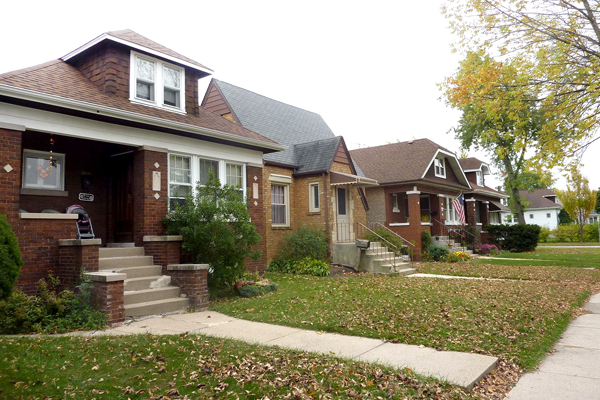
PHotograph: dennis rodkin
Homes in Brookfield, Illinois.
This month in the real estate market, there are lots of quick hand-offs, players guarding their positions and other basketball-ish stuff going on, but in this version of March Madness, what we’re most interested in seeing is a good solid rebound. And so far, that seems to be what we’re getting.
What we got last year was more like March Badness; that month, according to the Case-Shiller Index, Chicago’s home prices hit their lowest point during the housing bust. Prices rolled back to approximately where they had been in April 2000—which meant local homes hadn’t gained any value in 11 years and 11 months. Prices—and homeowners’ sense of financial health—spent much of the next year trying to climb out of that pit.
The pit is a big part of the reason that, as I wrote last week, only a little more than a third of the Chicago neighborhoods and suburbs we track for the annual home-value charts that are in the magazine’s April issue saw home prices rise during the course of 2012. March’s badness was difficult to overcome.
But there are signs, both on the charts (whose data ends with Dec. 31, 2012) and in more contemporary reports on what’s been happening so far this year, that recovery is on a firm footing—and that March 2013 may break the string of big price dips that have happened in February, March or April every year since the market first started heading down in 2007.
One good sign is the number of sales: In the six-county region that we track, 2012 saw 19.2% more sales than 2011. Sales were up 75% in Forest Park, one of the towns we suggested in the magazine story as a good spot for first-time buyers to go househunting. Another of those picks, Des Plaines, saw a 29% increase.
The trend seems to have continued after the close of our charts: Redfin reported this week that February 2013 sales volume in Chicago was 23.7% over February 2012’s figure (although down from January). That was the third biggest volume increase among the top 20 cities Redfin covers.
An increase in the number of homes sold is important because it means more buyers and sellers are able to change their positions—from a too-small condo to a family-sized house, for instance—and at the same time it pumps money through the economy as both sides spend on movers, new bathroom rugs, and whatever else the move precipitates.
But the even more auspicious data in our charts and in later reports is about how fast houses are selling. While some sellers still have homes lingering on the market—R. Kelly’s lender was the only bidder Monday when auctioning his former Olympia Fields home almost three years after it first went on the market—many other homes are barely touching down on the market before being sold.
That Redfin report above showed that 12.2% of homes sold in Chicago in February had gone in 14 days or less. That’s well below the national average of 34%, but great news in a market where just two and a half years ago, we saw home sales slowing down to a turtle’s pace.
On the charts, we see the speed-up starting in 2012: In most locations, homes sold faster in 2012 than during the prior year, although in very few are they selling as fast as in 2006.
The acceleration is giving some but not all neighborhoods whiplash. In Kenwood, homes sold 25% faster in 2012 than they had in 2006, while next door in Hyde Park, the pace is eight percent slower.
On the North Shore, homes sold significantly faster in Wilmette than in any other town in 2012. At 103 days, Wilmette sold 22% faster than second-place Evanston (132 days) and 59% faster than last-place Kenilworth (251 days).
The faster houses sell, the more likely they are to be bid up in price by buyers, and for the houses that follow them onto the market to have slightly higher prices. Which is all part of the step-by-step climb out of the hole, a process that this March appears to be continuing.
But one thing has me worried: this infernal weather. Cold, cold March 2013 hasn’t been anything like balmy March 2012, when there were eight days that the temperature topped 80 degrees. That felt good, and it might have made people feel optimistic about buying a house, where this month’s weather has made even the winter-hardiest of us kind of cranky. Data for home sales in March won’t be out for another several weeks, but fingers crossed that the good prices and low interest rates out-pulled the lousy weather in homebuyers’ heads.


